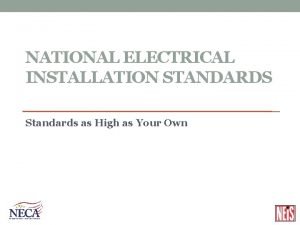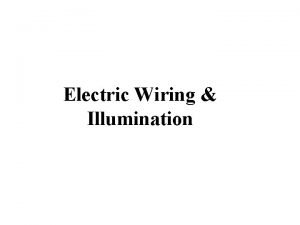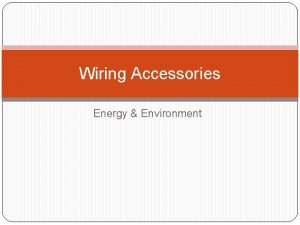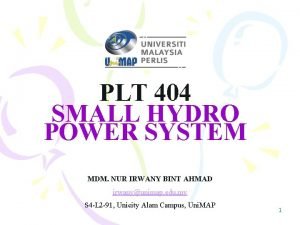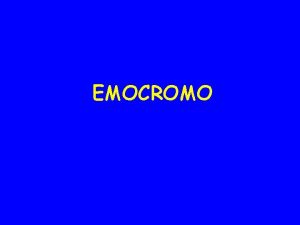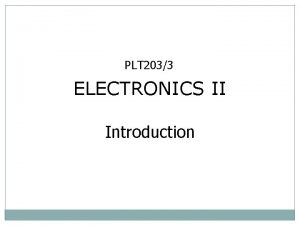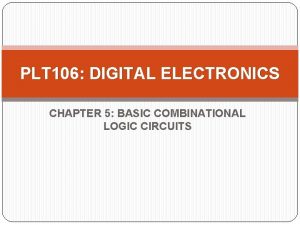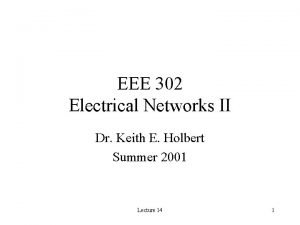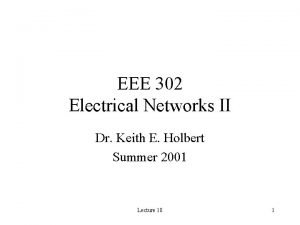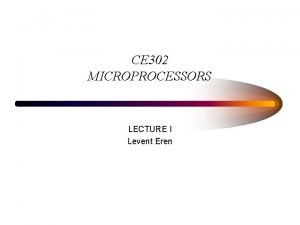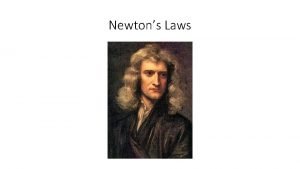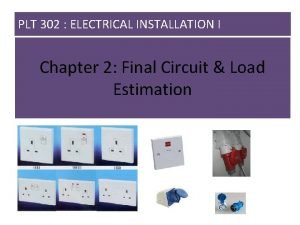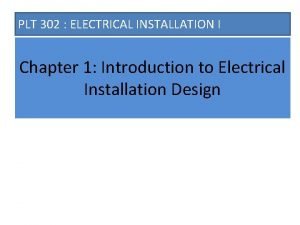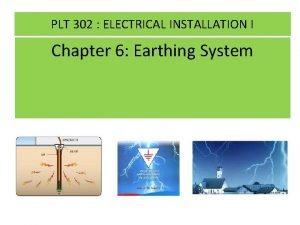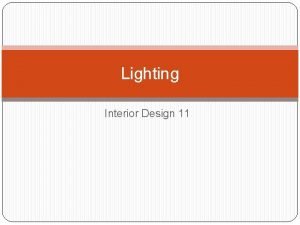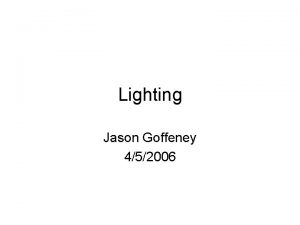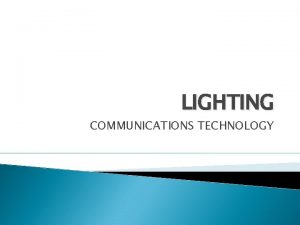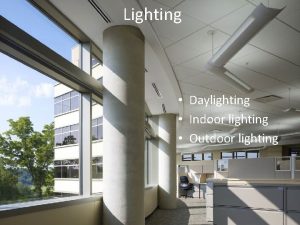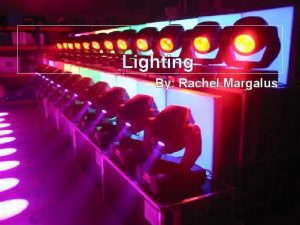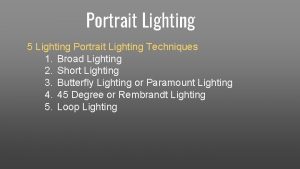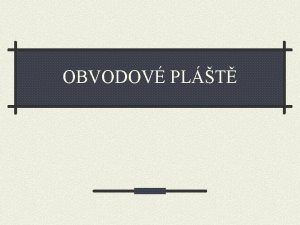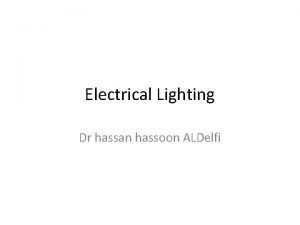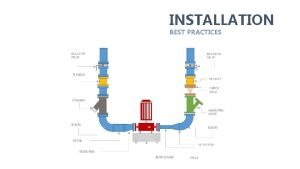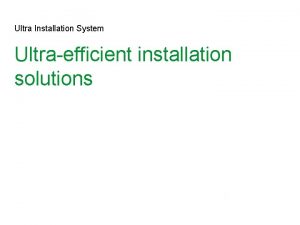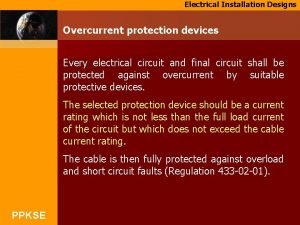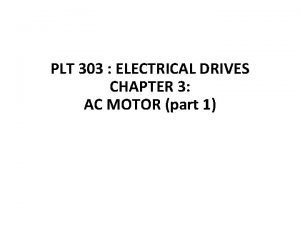PLT 302 ELECTRICAL INSTALLATION I Chapter 3 Lighting




































- Slides: 36

PLT 302 : ELECTRICAL INSTALLATION I Chapter 3: Lighting System & Design CHAPTER 3 LIGHTING SYSTEM AND DESIGN

3. 1 Definitions, Quantities and Units Luminaries An apparatus which controls the distribution of light from the source (lamp) and includes all the required fixing arrangements, connections and protections Luminous Flux/ Light Output The total quantity of light emitted per second by a light source. Lamp Lumens (lm) = the quantity of light emitted by a light source Unit: Lumens (lm) Faculty of Engineering Technology Sept 2014 Universiti Malaysia Perlis 2

3. 1 Definitions, Quantities and Units Luminous Efficacy The ratio of the light output (lumens) to the energy input (watts) Unit: lm/W Luminous Flux Density/Lighting Level The luminous flux per unit area , also known as the illuminance Unit : lux (lx) where 1 lx = 1 lm/m 2 Faculty of Engineering Technology Sept 2014 Universiti Malaysia Perlis 3

3. 1 Definitions, Quantities and Units Luminous Intensity, I A measure of light power of a source in a given direction Unit : candela (cd) Luminance, L A measure of the intensity of the light per unit area given off from surface in a given direction Unit : cd/m 2 Illuminance, E The luminous flux density at the surface or working plane Unit : lux (lx) Luminous intensity of a luminaire or lamp in all spatial directions and is normally shown in the form of a polar curve Faculty of Engineering Technology Sept 2014 Universiti Malaysia Perlis 4

3. 1 Definitions, Quantities and Units Polar Curve Ø is a schematic figure of the luminous intensity (Candela) distribution of the luminaire. Ø the shape of the polar curves indicates the way in which the luminaire controls of the light distribution from the lamp. Faculty of Engineering Technology Sept 2014 Universiti Malaysia Perlis 5

3. 2 Generation of Light 3. 2. 1 Light Source Generally, a electric light sources can be divided into three types such as: i. Incandescent ii. Luminescence iii. Electroluminescence Faculty of Engineering Technology Sept 2014 Universiti Malaysia Perlis 6

3. 2 Generation of Light 3. 2. 1. 1 Incandescent • Solids and liquids emit visible radiation when they are heated to temperatures aboves 1000 K. • The intensity increases and the appearance becomes whiter as the temperature increases. • This phenomenon is known as incandescence or temperature radiation. Faculty of Engineering Technology Sept 2014 Universiti Malaysia Perlis 7

3. 2 Generation of Light 3. 2. 1. 2 Luminescene • Luminescence is the emission of light not ascribed directly to incandescence. • Two important types of luminescence are electric or gas discharge, and fluorescence. Faculty of Engineering Technology Sept 2014 Universiti Malaysia Perlis 8

3. 2 Generation of Light 3. 2. 1. 3 Electroluminescence • Electroluminescence is the emission of light when low voltage direct current is applied to a semi-conductor device containing a crystal and a p-n junction. • The most common electroluminescent device is the LED. Faculty of Engineering Technology Sept 2014 Universiti Malaysia Perlis 9

3. 2 Generation of Light 3. 2. 2 Lamp Type Ø Definition An electric lamp is a device converting electric energy into light. Ø Lamp Types by Light Generation Method i) Incandescent lamps ii)Gas discharge lamps ü High pressure or HID ü Mercury vapour (MV) ü Metal halide (MH) lamps ü High pressure sodium (HPS) lamps iii) Electroluminescent lamps - LEDs Faculty of Engineering Technology Sept 2014 Universiti Malaysia Perlis 10

3. 2 Generation of Light 3. 2. 2 Lamp Type Ø Types by Standard Classification q Incandescent lamps q Fluorescent lamp q HID lamps i. mercury vapour (MV) lamps ii. metal halide (MH) lamps iii. high pressure sodium (HPS) lamps q Low pressure sodium (LPS) lamps q LED sources Faculty of Engineering Technology Sept 2014 Universiti Malaysia Perlis 11

3. 2 Generation of Light 3. 2. 3 Lighting Systems a) Lighting Unit or Luminaire A lighting unit consists of: ü a lamp or lamps ü a ballast (for gas discharge lamps) ü a fixture or housing ü an internal wiring and sockets ü a diffuser (louver or lens). b) Lighting System A typical lighting system consists of: ü luminaires ü lighting control system(s). c) Lighting System Environment A lighting system environment consists of: ü room (ceiling, wall, floor) ü room objects. Faculty of Engineering Technology Sept 2014 Universiti Malaysia Perlis 12

3. 2 Generation of Light 3. 2. 4 Incandescent Light 3. 2. 4. 1 Standard incandescent light Ø Construction A typical construction of an incandescent lamp is shown in the Figure 9. An incandescent lamp produces light by using electric current to heat a metallic filament to a high temperature (above 5000° C/ 9000° F). A tungsten filament is used because of its high melting point and low rate of evaporation at high temperatures. The filament is coiled to shorten the overall length and to reduce thermal loss. The filament is enclosed in a glass bulb filled with inert gas at low pressure. The inert gas permits operation at higher temperatures, compared to vacuum, resulting in a smaller evaporation rate of the filament. The bulbs are often frosted on the inside to provide a diffused light instead of the glaring brightness of the unconcealed filament. Faculty of Engineering Technology Sept 2014 Universiti Malaysia Perlis 13

3. 2 Generation of Light Shape A B BR C ER F G P PAR S T = Arbitrary (standard) - universal use for home lighting = Bullet - decorative = Bulging reflector - for substitution of incandescent R lamps = Cone shape - used mostly for small appliances and indicator lamps = Elliptical reflector - for substitution of incandescent R lamps = Flame - decorative interior lighting = Globe - ornamental lighting and some floodlights = Pear - standard for streetcar and locomotive headlights = Parabolic a. Iuminized - used in spotlights and floodlights reflector = Straight - lower wattage lamps - sign and decorative Faculty of Engineering Technology Sept 2014 = Tubular – showcase and appliance lighting Universiti Malaysia Perlis 14

3. 2 Generation of Light 3. 2. 4 Incandescent Light 3. 2. 4. 2 Tungsten Halogen Lamp Ø Construction The quartz tungsten halogen lamp is another type of incandescent lamp. The conventional incandescent lamp loses filament material by evaporation which is deposited on the bulb wall, leading to bulb blackening and reduced lamp efficacy during the life of the lamp. When a halogen element is added to the filling gas under certain design conditions, a chemical reaction occurs, as a result of which evaporated tungsten is redeposited on the filament, preventing any deposits on the bulb wall. The bulb of the tungsten halogen lamp is normally made of quartz glass to withstand the lamp’s high-temperature operating conditions. The fixture often incorporates a reflector for better heat dissipation and beam control. Faculty of Engineering Technology Sept 2014 Universiti Malaysia Perlis 15

3. 2 Generation of Light Shape Tubular: T 3 Tubular: T 10 Tubular: T 6 Tubular: T-4 Tubular: T-3 Maxi-spot Mini-spot PAR 36 MR 16 : Line voltage tungsten halogen lamp - double-ended : Line voltage tungsten halogen lamp - single-ended : Line voltage tungsten halogen lamp - without reflector : Low voltage tungsten halogen lamp - with reflector : Low voltage tungsten halogen lamp - PAR 36 reflector : Low voltage tungsten halogen lamp – MR 16 Reflector Faculty of Engineering Technology Sept 2014 Universiti Malaysia Perlis 16

3. 2 Generation of Light 3. 2. 4 Incandescent Light 3. 2. 4. 3 Halogen PAR Lamp General Description Halogen PAR lamps are lamps with a Parabolic Aluminum Reflector (PAR) which use a halogen capsule instead of a simple filament. The halogen capsule includes a tungsten filament and halogen gas. PAR Lamp Families PAR lamps have evolved into four families, listed below, from lowest to highest efficiency: i. standard PAR lamps ii. energy saving PAR lamps iii. halogen PAR lamps iv. Infra Red (IR) halogen PAR lamps. Faculty of Engineering Technology Sept 2014 Universiti Malaysia Perlis 17

3. 2 Generation of Light • All PAR lamps have an aluminum or silver coating reflector on part of the bulb’s surface. PAR lamps are used for directional lighting, i. e. , highlighting or spot lighting. • Most common size is the PAR 38 and other sizes include PAR 30, PAR 20 and PAR 16. • Beam spreads are described as narrow spot (NS), spot (SP) and flood (FL). Halogen PAR Lamps • Halogen PAR lamps use a halogen capsule instead of a tungsten filament. • Lamp watts: 45 W, 65 W, 90 W. • Life: 2, 000 hours. Applications • Downlights, • Accent lighting, • Outdoor lighting. Faculty of Engineering Technology Sept 2014 Universiti Malaysia Perlis 18

3. 2 Generation of Light Advantages Halogen PAR lamps have many advantages over standard and energy saving PAR lamps: • energy savings in the order of 40% - 60%; • whiter light; • constant light output throughout lamp life without lamp darkening. Limitations Halogen PAR lamps are more expensive than standard and energy saving PAR. Assessment • Halogen PAR lamps provide energy savings which outweigh the lamp price difference in less than a year. • Halogen PAR lamps provide better quality light. Faculty of Engineering Technology Sept 2014 Universiti Malaysia Perlis 19

3. 2 Generation of Light 3. 2. 4. 4 Gas Discharge Lamp i. Low Pressure Discharge 1) Fluorescent Lamp (Low pressure mercury vapour lamp) Construction üA fluorescent lamp is a low-pressure mercury electric discharge lamp. üA fluorescent lamp consists of a glass tube filled with a mixture of argon gas and mercury vapour at low pressure. üWhen current flows through the ionized gas between the electrodes, it emits üultraviolet (UV) radiation from the mercury arc. üThe UV radiation is converted to visible light by a fluorescent coating on the inside of the tube. üThe lamp is connected to the power source through a ballast, which provides the necessary starting voltage and operating current. Faculty of Engineering Technology Sept 2014 Universiti Malaysia Perlis 20

3. 3 Calculation of Lighting Requirement 3. 3. 1 Inverse Square If we were to illuminate a surface by means of a lamp positioned vertically above it, measure the illumination at the surface, and then move the lamp twice as far away, the illumination now measured would be four times less. Faculty of Engineering Technology Sept 2014 Universiti Malaysia Perlis 21

3. 3 Calculation of Lighting Requirement If it were moved away three times the original distance the illumination would be nine times less. Hence it will be seen that the illuminance on a surface is governed by the square of the vertical distance of the source from the surface Therefore Faculty of Engineering Technology Sept 2014 Universiti Malaysia Perlis 22

3. 3 Calculation of Lighting Requirement 3. 3. 2 Cosine Rule From figure below it will be seen that point X is further from the source than is point Y. The illuminance at this point is therefore less. In fact the illuminance at X depends on the cosine of the angle θ. Hence, Faculty of Engineering Technology Sept 2014 Universiti Malaysia Perlis 23

3. 3 Calculation of Lighting Requirement Example 1 A light source of 900 candelas is situated 3 m above a working surface. Calculate the illuminance directly below the source. What would be the illuminace if the lamp were moved to a position 4 m from the surface? Faculty of Engineering Technology Sept 2014 Universiti Malaysia Perlis 24

3. 3 Calculation of Lighting Requirement Example 2 A 250 W sodium vapour street lamp emits a light of 22500 cd and is situated 5 m above the road. Calculate the illuminance a) direct below the lamp and b) at a horizontal distance along the road of 6 m. Faculty of Engineering Technology Sept 2014 Universiti Malaysia Perlis 25

3. 4 Lighting Design In lighting design, an electrical engineer has to ensure that his design provides adequate lighting. The level of illumination attained must follow the requirement of IES Code or JKR Standards as shown in Table 1. Room Index Room index is related to the room dimensions and used when calculating the utilisation factor and other characteristics of a lighting installation. L = Length of room W = Width of room Hm = Mounting height of luminaire above the working plane The reflection factors of room surfaces are take into consideration the reflection of illuminance from ceilings, walls and floor. Faculty of Engineering Technology Sept 2014 Universiti Malaysia Perlis 26

3. 4 Lighting Design Lumen method of calculation The level of illuminance is places such as industrial workrooms and offices are usually prescribed in terms of the average illuminance on a horizontal working plane. To design a lighting scheme that will produce the desired level of illuminance, the quantity of luminaires must be determined. This is performed by a calculation known as the lumen method. where: N = Number of luminaires required obtained lamp each initial manufacturers’ lumens from The of LDL = multiplied data by the number of lamps in each luminaire Co. U = Coefficient of Utilisation or Utilisation factor MF = Maintenace factor L = Length of room W = Width of room Eav maintained illuminance) Faculty of Engineering Technology Universiti Malaysia Perlis Sept 2014 27

3. 4 Lighting Design In order to find the coefficient of utilisation, Co. U, the room index, K must be calculated first. Having done this assessment is made of the room reflectance. Both room index and reflector factors are then applied to the manufacturers’ photometric data to determine the utilisation factor for the luminaire. Faculty of Engineering Technology Sept 2014 Universiti Malaysia Perlis 28

3. 4 Uniformity of Illuminance üThe uniformity of illuminance for an indoor lighting scheme is one of the many important factors that must be considered during the initial planning stage. üUniformity of illuminance is achieved by limiting the spacing between the centres of each luminaire. Faculty of Engineering Technology Sept 2014 Universiti Malaysia Perlis 29

3. 4 Uniformity of Illuminance üThe maximum spacing, S permitted is determined by the luminous intensity distribution (polar curve) of the luminaire and its mounting height, Hc above the working plane. üThe desk height above floor for office (0. 7 m) or 0. 85 m for industry. ü Spacing to height ratio is the spacing between the centres of the luminaries divided by their height above the working plane. Faculty of Engineering Technology Sept 2014 Universiti Malaysia Perlis 30

Example 3 If a SHR MAX = 1. 4 is stated for luminaire in figure above and the mounting height of luminaire above the working plane is 1. 9 m then the maximum spacing on either direction can be calculated as follows: Therefore, maximum spacing, S = 1. 9 x 1. 4 = 2. 66 m Faculty of Engineering Technology Sept 2014 Universiti Malaysia Perlis 31

Example 3 Faculty of Engineering Technology Sept 2014 Universiti Malaysia Perlis 32

3. 4 Uniformity of Illuminance If the spacing height ratio is exceeded then there will be areas between luminaries which will have serious reduction of illuminance as shown in figure below It is recommended that the ratio of the minimum illuminance to the average illumainance over the working plane should not less than 80%. Faculty of Engineering Technology Sept 2014 Universiti Malaysia Perlis 33

3. 4 Uniformity of Illuminance Ø In the case of fluorescent luminaires that do not have an axially symmetrical intensity distribution, maximum spacing information stated in the photometric data may be indicate: SHR MAX and SHR MAX TR Ø In these circumstances, three conditions must be complied with: i. The spacing in the transverse direction (SHR TR) must not exceed SHR MAX TR stated. ii. The spacing in the axial direction (SHR AX) must not exceed the SHR MAX stated. iii. The actual spacings in the two directions (SHR AXIAL and SHR TRANSVERSE) when multiplied together must not exceed (SHR MAX)2. Faculty of Engineering Technology Sept 2014 Universiti Malaysia Perlis 34

3. 4 Uniformity of Illuminance Faculty of Engineering Technology Sept 2014 Universiti Malaysia Perlis 35

3. 4 Example 4 An office area requires an average illuminance of 500 lux on the working plane, 0. 75 m from the floor. Office dimensions are 10 m long by 6 m wide. Ceiling height is 2. 68 m and painted white. Walls have also a light finished surface. Room surface reflection factors are: Ceiling, C = 0. 70 Walls, W = 0. 50 Floor, F = 0. 20 Assume a maintenance factor to be 0. 85. Determines the total number of luminaires for the offices together with a plan view of their spacing arrangement for these types of lamp is used in this lighting design: i. TL-5 (3 x 36 W) ii. LED downlight iii. CFL downlight Faculty of Engineering Technology Sept 2014 Universiti Malaysia Perlis 36
 Ansi/neca 1-2015
Ansi/neca 1-2015 Electrical installation accessories
Electrical installation accessories Electrical conduit installation estimating
Electrical conduit installation estimating Conductors and cables n2
Conductors and cables n2 3 pin plug wiring
3 pin plug wiring Plt abn distribution meaning
Plt abn distribution meaning Plt histogram abn
Plt histogram abn Mdm hydra
Mdm hydra Distribuzione volumetrica plt
Distribuzione volumetrica plt Plt scheme
Plt scheme Fuzzification
Fuzzification Plt electronics
Plt electronics Plt 106
Plt 106 Voltage classification
Voltage classification Fcps my plt
Fcps my plt Cbc with plt
Cbc with plt Plt uts
Plt uts คืออะไร
คืออะไร คืออะไร
คืออะไร Import numpy as np import matplotlib.pyplot as plt
Import numpy as np import matplotlib.pyplot as plt Anu gdlp
Anu gdlp Plt
Plt Plt.triplot
Plt.triplot Billy b and plt
Billy b and plt Plt skills
Plt skills Plt skills
Plt skills Kewenangan plt dan plh dalam aspek keuangan
Kewenangan plt dan plh dalam aspek keuangan Fibrinolitikler
Fibrinolitikler 7285 x 302
7285 x 302 302 commitment
302 commitment Mat 302 bmcc
Mat 302 bmcc Edu 302
Edu 302 Eee 302
Eee 302 Eee 302
Eee 302 Ce 302
Ce 302 No mundo murmura se tanto
No mundo murmura se tanto I went into the garden
I went into the garden
